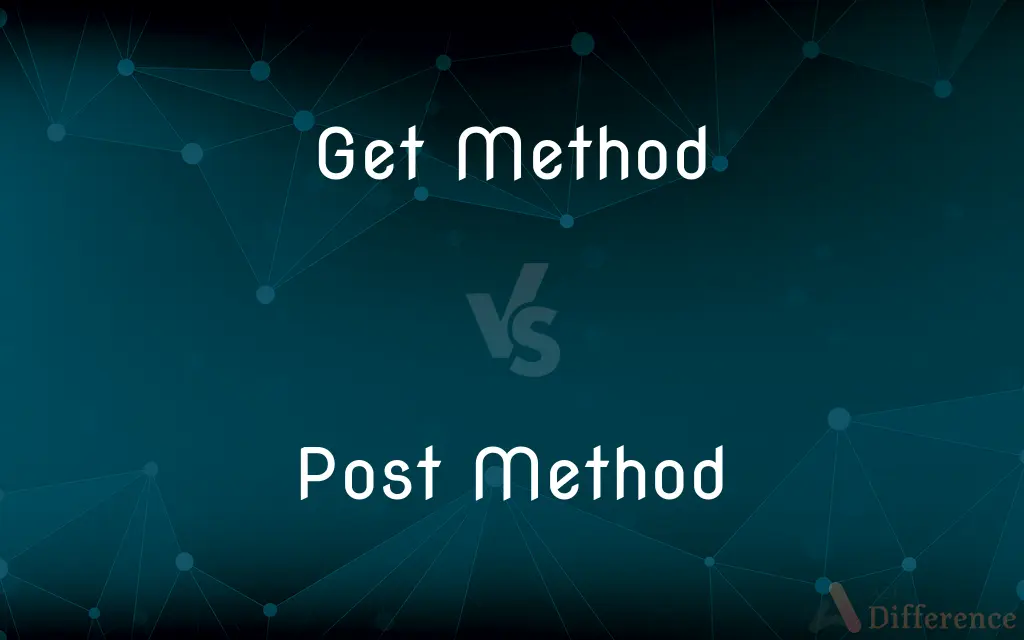Get Method vs. Post Method — What's the Difference?
By Tayyaba Rehman — Published on December 15, 2023
Get Method: retrieves data; visible URL. Post Method: submits data; data not shown. Both HTTP requests, different data handling.

Difference Between Get Method and Post Method
Table of Contents
ADVERTISEMENT
Key Differences
The Get Method, in the context of HTTP and web development, is used primarily to retrieve data from a specified resource. It's important to note that the Get Method appends data into the URL in a query string. This means that the parameters are stored in the server logs and browser history. The Post Method, however, is utilized when the data needs to be submitted to be processed to a specified resource. It passes the information via the HTTP header, so the data does not appear in the URL or server logs.
The Get Method is ideal for fetching documents, where the user is requesting data or resources that require no modification on the server side. It's a standard method for requesting data from a website and is used every time you see a URL or link on a webpage. The Post Method is employed when users need to upload a file or submit a completed web form. In scenarios where user authentication is necessary or data must remain confidential, the Post Method is more appropriate because the information transmitted is not visible.
One significant limitation of the Get Method is the amount of data that can be sent, which is restricted by the URL length (a maximum of 2048 characters). This is because the data is appended to the URL. The Post Method does not have this restriction. It allows large quantities of data to be submitted because the data is sent in the body of the HTTP request, not in the URL.
The Get Method is idempotent, meaning that multiple identical requests will have the same effect as a single request. The responses to Get Method requests are cacheable, which means they can be stored to save time on repeated requests. Conversely, the Post Method is non-idempotent. If you make two identical Post Method requests, they may have different effects, and the responses are not cacheable by default.
Security-wise, the Get Method is less secure compared to the Post Method as the data sent is part of the URL. So, it's saved in browser history and server logs. The Post Method, being more secure, encapsulates the data inside the request body, which is not stored anywhere. However, both Get Method and Post Method are not inherently secure; data sent using both methods can be intercepted unless an SSL/TLS layer secures the communication.
ADVERTISEMENT
Comparison Chart
Data Location
URL
Request body
Data Size
Limited
No limit
Visibility
Data visible in URL
Data not displayed
Idempotency
Idempotent
Non-idempotent
Security
Less secure
More secure
Compare with Definitions
Get Method
Appends data to the URL.
Sensitive data should not be sent via the Get Method because it appears in the URL.
Post Method
Non-idempotent operation.
Making the same Post Method request twice resulted in two submissions.
Get Method
Limited by URL length.
We can't use the Get Method because the dataset is too large.
Post Method
Offers more data security.
The application used the Post Method to safely transmit sensitive user data.
Get Method
Used to retrieve information.
The website used the Get Method to display search results.
Post Method
No restriction on data size.
The Post Method was necessary to handle the large file upload.
Get Method
Data is visible and stored.
Avoid the Get Method for confidential information as it's saved in browser history.
Post Method
Used for submitting data.
User registration forms typically use the Post Method.
Get Method
Idempotent operation.
Repeatedly refreshing the browser sent multiple Get Method requests, but the result was unchanged.
Post Method
Data contained in the request body.
The Post Method secured the data in the HTTP header, away from prying eyes.
Common Curiosities
Is the Get Method secure for confidential information?
No, the Get Method exposes data in the URL, making it unsuitable for confidential information.
What does the Post Method do?
The Post Method submits data to be processed to a specified resource, encapsulating data in the request body.
Is data sent via Get Method visible?
Yes, data sent using the Get Method appears in the URL.
Do browsers cache Post Method responses?
No, responses to Post Method requests are generally not cached.
Are Post Method requests visible in the URL?
No, data sent via the Post Method is contained in the request body, not displayed in the URL.
How do I choose between the Get Method and the Post Method?
Choose the Get Method for retrieving data; opt for the Post Method when submitting data, especially if large or sensitive.
What is the Get Method?
The Get Method is an HTTP request for retrieving data from a server, visible in the URL.
Can the Post Method handle large data?
Yes, the Post Method can transmit large amounts of data, as it's included in the request body.
Can the Get Method modify data on the server?
No, the Get Method is intended for data retrieval without server-side effects.
Is the Post Method idempotent?
No, repeated identical requests via Post Method may have different effects.
Are the Get Method requests faster than Post Method ones?
Get Method requests might be slightly faster due to their simplicity and caching, but it depends on various factors.
What's the data limit for the Get Method?
The Get Method is constrained by URL length, usually up to 2048 characters.
Why don't we use the Get Method for file uploads?
Due to URL length limitations and data visibility, the Get Method is unsuitable for file uploads.
Can the Post Method be used for retrieving data?
While typically for submitting data, the Post Method can technically retrieve data, though it's unconventional.
How does SSL affect the Get Method and Post Method?
SSL secures the data transmitted by both methods, but the Post Method remains preferable for sensitive data due to its encapsulation in the body.
Share Your Discovery

Previous Comparison
Roku Stick vs. Amazon Fire Stick
Next Comparison
Redken Ph Bonder vs. OlaplexAuthor Spotlight
Written by
Tayyaba RehmanTayyaba Rehman is a distinguished writer, currently serving as a primary contributor to askdifference.com. As a researcher in semantics and etymology, Tayyaba's passion for the complexity of languages and their distinctions has found a perfect home on the platform. Tayyaba delves into the intricacies of language, distinguishing between commonly confused words and phrases, thereby providing clarity for readers worldwide.












































